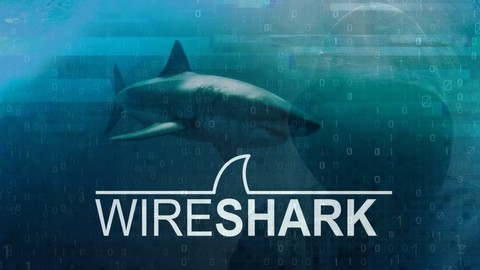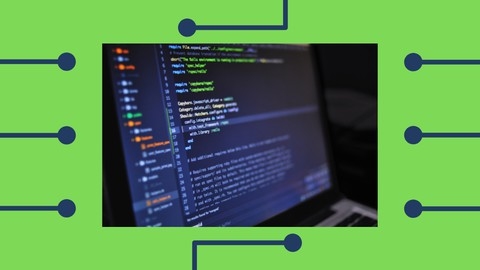Wireshark is a powerful network analysis tool that allows users to capture and inspect network traffic.
This tool can be used to troubleshoot network problems, analyze security threats, and even conduct ethical hacking.
Understanding Wireshark opens up opportunities in cybersecurity, network administration, and IT support, allowing you to gain deep insight into how data flows and interacts on networks.
You can even use this knowledge to diagnose and solve issues like slow internet speeds or pinpoint the source of malicious activity.
Finding the right Wireshark course on Udemy can be tricky, with so many options available.
You’re looking for a course that’s comprehensive, engaging, and taught by experts who can guide you through its complex features.
You need a course that goes beyond the basics and teaches you how to use Wireshark like a pro.
For the best Wireshark course overall on Udemy, we recommend Wireshark: Packet Analysis and Ethical Hacking: Core Skills.
This course is a comprehensive introduction to Wireshark, covering everything from the basics of packet capture and analysis to more advanced topics like ethical hacking.
The instructor provides clear explanations and engaging examples, making it a great option for both beginners and experienced users.
This course is just one of many excellent Wireshark options available.
Keep reading for more recommendations for different learning styles and goals, including courses focused on specific Wireshark features, network security, and ethical hacking.
Wireshark: Packet Analysis and Ethical Hacking: Core Skills
The course starts with the basics, guiding you through installing Wireshark on both Windows and Mac OS.
You’ll learn how to capture packets and frames, and troubleshoot common issues like no packets being captured.
The instructor also covers advanced topics like port mirroring and SPAN to give you a solid foundation.
Next, you’ll dive deep into the OSI model, learning about each layer from the Application Layer down to the Physical Layer.
This knowledge is crucial for understanding how data flows through networks and where vulnerabilities can occur.
The course explains complex concepts like encapsulation and the differences between the TCP/IP and OSI models in an easy-to-grasp manner.
With a solid theoretical foundation, you’ll move on to practical skills like using Wireshark filters to zero in on specific IP addresses or protocols.
This is where the real fun begins, as you learn how to capture and analyze traffic to detect issues and potential security breaches.
One of the most eye-opening sections covers how to use Wireshark for password hacking.
You’ll see how easy it is to capture passwords from common protocols like Telnet, FTP, and HTTP, including from Cisco router web interfaces.
The course even demonstrates capturing and replaying VoIP calls, showcasing how vulnerable unencrypted communication can be.
But this course goes beyond just offense.
You’ll learn how to play the role of a network detective, analyzing packet captures to troubleshoot issues with protocols like OSPF, EIGRP, and BGP.
The instructor presents you with realistic scenarios and challenges you to identify the root cause, then walks through the solution.
The course also covers advanced topics like using Wireshark with the popular Kali Linux penetration testing distribution.
You’ll see live demonstrations of DTP, VTP, and spanning tree attacks, along with how to perform DHCP starvation and man-in-the-middle attacks.
These practical demos are fantastic for understanding real-world attack vectors.
You’ll also learn how to integrate Wireshark with Python for automating tasks and building your own analysis tools.
The instructor demonstrates capturing OSPF and FTP passwords using Python scripts, showcasing the power of combining your packet analysis knowledge with programming.
Throughout the course, you’ll test your skills with quizzes and practice what you’ve learned with guided labs in GNS3 and virtual machines.
This hands-on approach reinforces your knowledge and gives you the confidence to apply these skills in real network environments.
From fundamentals like the OSI model and Wireshark filters to advanced topics like packet decryption and programmatic analysis with Python, you’ll gain a versatile toolkit for analyzing and securing networks.
Getting Started with Wireshark: The Ultimate Hands-On Course
You’ll start by setting up Wireshark and its command-line tools, learning the fundamentals of navigating the interface.
The course then dives into customizing Wireshark to your needs, with sections on creating profiles, adding custom columns, and coloring traffic for easier analysis.
You’ll quickly learn how to filter traffic effectively, understanding the difference between capture filters and display filters.
You’ll become adept at filtering by IP addresses, ports, protocols, and even conversations using operators like ‘contains,’ ‘matches,’ and ‘in’.
The course also covers capturing packets effectively, exploring the differences between local capture, SPAN, and TAP methods.
You’ll learn to capture intermittent problems using long-term capture configurations and the command-line tool Dumpcap, ensuring you can troubleshoot even the most elusive network issues.
Moving beyond the basics, you’ll delve into the anatomy of a packet, exploring the OSI model and examining the Ethernet frame header and the Internet Protocol in detail.
The course provides practical guidance on analyzing IP packets, helping you understand the IP ID, TTL field, and how IP fragmentation works.
You’ll also learn about IPv6 and how to use GeoIP to pinpoint geographical locations, crucial for investigating network security events.
The course doesn’t stop at the theoretical.
You’ll gain practical skills in analyzing UDP and TCP protocols.
You’ll learn how DHCP works, troubleshoot VoIP and video streams, and analyze DNS requests.
The course offers in-depth coverage of TCP handshakes, flags, options, sequence numbers, acknowledgments, and retransmissions, empowering you to pinpoint and solve common network problems like slow file transfers and network disconnects.
Finally, you’ll put everything you’ve learned into practice by tackling real-world network problems like slow application response time, high network latency, packet loss, and TCP window issues.
Start Using Wireshark to Hack like a Pro
You’ll start by learning the fundamentals of capturing and interpreting network traffic, covering concepts like DNS, ARP, and how communication works at the packet level.
You’ll gain hands-on experience through practical exercises, including capturing live traffic and analyzing static capture files.
The course emphasizes the importance of understanding TCP/IP protocols and how to use Wireshark to analyze them effectively.
As you progress, you’ll delve into more advanced techniques like crafting filters to isolate specific traffic and identifying potential security incidents by analyzing suspicious network activity.
You’ll even get to explore real-world scenarios by examining bonus capture files and practicing your skills in identifying potential signs of compromise.
The course concludes with an introduction to the steps involved in professional hacking methodology, giving you a glimpse into the attacker’s mindset.
This section covers techniques like scanning, exploitation, and post-exploitation, and even shows you how to extract files from Wireshark captures, a valuable skill for malware investigation.
Wireshark MASTERY - Work From Home Jobs with WIRESHARK!
This course offers a comprehensive dive into the world of Wireshark, equipping you with the skills to analyze network traffic and become a valuable asset in any IT environment.
You’ll start by building a solid foundation in networking principles, understanding the fundamentals of how networks are designed and how Wireshark fits into the picture.
Get ready to delve into the intricacies of the OSI and TCP/IP models, the backbone of computer communication, and learn how to install Wireshark on Mac, Windows, and Linux.
You’ll then master navigating Wireshark’s user interface and using filters to dissect various types of network traffic.
Prepare to go hands-on, capturing and analyzing real network data to identify unauthorized access and even uncover what users are downloading.
The course goes beyond the basics, covering remote capturing, data exporting, and understanding I/O graphs, giving you a deep understanding of data analysis.
You’ll even learn to wield the powerful command-line interface with Tshark, gaining mastery over this essential tool.
The curriculum explores specific protocols like TCP, HTTPS, DHCP, and DNS, providing in-depth insights into how they work.
You’ll wrap up the course with practical examples that demonstrate how to use Wireshark to troubleshoot real-world problems, analyzing DNS, HTTP traffic, and email communications.
This course doesn’t just equip you with technical skills; it opens the door to potential career paths.
You’ll explore Wireshark certifications and discover the exciting opportunities that lie ahead for network security professionals.
Get ready to take your network analysis expertise to the next level!
Learning Path: Wireshark -The Advanced Network Analysis Tool
You’ll start by understanding the fundamentals of protocol analyzers and familiarizing yourself with Wireshark’s user interface.
You’ll then dive into setting up and configuring Wireshark for capturing and analyzing network data, including the intricacies of the protocol stack.
The course goes beyond the basics, teaching you essential techniques like utilizing display and capture filters to pinpoint specific network events.
You’ll discover how to customize Wireshark’s display to suit your needs and master saving and managing captured data.
As you progress, you’ll explore advanced analysis techniques like following network streams, deciphering time values, and leveraging the expert system.
You’ll delve into common network protocols like DNS, VoIP, DHCP, and TCP/IP, gaining a deeper understanding of their functionality and troubleshooting common issues.
This course doesn’t shy away from practical application.
You’ll learn how to use Wireshark to analyze different types of network traffic, such as email, HTTP, FTP, and 802.11 traffic, equipping you with the skills to confidently diagnose network problems.
The course concludes with engaging practical scenarios, allowing you to apply your newfound knowledge to real-world situations.
These scenarios will enhance your understanding of network behavior and provide valuable experience for tackling complex network environments.
Wireshark Crash Course
This Wireshark Crash Course is a solid introduction to network analysis, particularly for those new to the field.
It covers the essential fundamentals of Wireshark, equipping you with the skills needed to capture and analyze network traffic effectively.
You’ll start by understanding what Wireshark is and its applications, then dive into installation on various platforms (Windows, Mac, Linux).
The course guides you through capturing network traffic, introducing you to the powerful filters that let you focus on specific types of data.
You’ll also gain a foundational understanding of the OSI model and how it relates to Wireshark, providing context for the layers of communication you’ll be analyzing.
The course explores the diverse tools within Wireshark, including its interface, display filters, and capabilities for rebuilding conversations and exporting objects.
Moving beyond the basics, you’ll be introduced to the tshark command-line tool, learning how to extract data, carve packet streams, and even identify potentially malicious IP addresses.
The course doesn’t stop there—you’ll also get a taste of TCPDUMP, a powerful command-line tool for network analysis.
The course is well-structured and easy to follow, with numerous examples to solidify your learning.
While the instructor’s teaching style is clear and concise, the course could benefit from incorporating more interactive elements or real-world case studies to enhance engagement.
While a few additional features could enhance the learning experience, the course effectively delivers the core skills needed to confidently navigate and analyze network traffic using Wireshark.
The Ultimate Wireshark Course
If you’re looking to master network security analysis, this Wireshark course offers a comprehensive and practical learning experience.
You’ll delve deep into the foundational principles of networking, including the TCP/IP and OSI models, gaining a solid understanding of how data travels across networks.
The course’s core focus lies in equipping you with the skills to utilize Wireshark, the industry-standard network packet analyzer.
From basic capture filters and protocol dissectors to advanced threat hunting techniques and geolocation analysis, you’ll learn how to effectively navigate Wireshark and extract valuable insights from network traffic.
But this isn’t just about theory.
You’ll also explore the power of Brim, a robust network analysis tool that seamlessly integrates with Wireshark.
You’ll discover how to install and use Brim to investigate malware, detect suspicious activity, and gain critical insights into real-world security threats.
To solidify your learning, you’ll be challenged with a real-world incident analysis involving Covenant C2, a popular command-and-control framework used by attackers.
This hands-on experience will provide valuable practical application of your newly acquired skills.
The course also introduces you to PacketTotal.com, a valuable resource for threat intelligence, further expanding your understanding of the security landscape.
And for a glimpse into the exciting world of ethical hacking, you’ll be exposed to red teaming concepts, giving you a broader perspective on network security.
Mastering Network Troubleshooting with Wireshark
This course offers a comprehensive exploration of Wireshark, a powerful tool for network analysis and troubleshooting.
You’ll gain a solid understanding of its capabilities, starting with the fundamentals of downloading, installing, and navigating the user interface.
The course emphasizes capturing and filtering network traffic, skills essential for understanding network activity.
You’ll learn how to effectively use Wireshark’s filter language to isolate specific data within complex network captures.
Beyond the basics, you’ll delve into analyzing captured data.
The course teaches you to examine each layer of a network capture, providing valuable insights into the flow of information.
You’ll also be introduced to RFCs (Request for Comments), technical documents that define network protocols.
This understanding is crucial for accurately interpreting the data you capture.
The course doesn’t stop at basic capture and analysis.
It explores advanced techniques like comparison and simultaneous capture, allowing you to gain deeper insights into network behavior.
You’ll also learn how to troubleshoot specific network problems, including TCP checksum errors, and differentiate between valid and invalid retransmissions.
The course even delves into the important concepts of IP MTU and PMTU discovery, which are vital for diagnosing network performance issues.
This course provides a strong foundation in Wireshark, covering both essential techniques and advanced concepts.
If you’re serious about mastering network analysis and troubleshooting, this is a valuable resource to consider.








